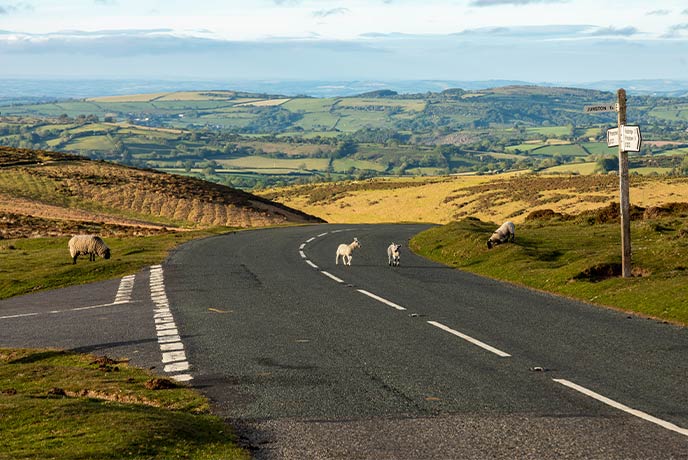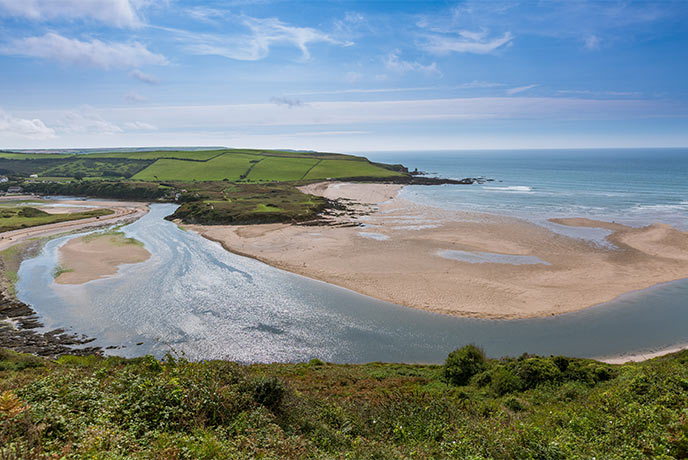From exquisite family homes to romantic ruins, nothing quite defines our history like a castle, and Devon has them by the dozen. Whether perched high overlooking a bustling town, gripping tight to the coastline ready to protect our shores, or surrounded by stunning countryside, Devon’s castles and fortresses are truly incredible and a must-see during any visit to this beautiful county.
Step inside these majestic edifices and you’re immediately taken back to a bygone age, where kings, knights, and lords reigned over their subjects and defended them in battle, where medieval wall hangings sit comfortably next to electric candlesticks, and gorgeous manicured gardens wait to be discovered.
Managed by the National Trust, English Heritage or privately owned, you’ll find tea rooms and cafés ready to serve up mouth-watering Devonshire cream teas, top picnic spots on a sunny day, and great little shops offering gifts and souvenirs galore – and many of them are dog-friendly too!
Here’s a selection of Devon’s most fascinating and picturesque castles to explore for yourself…
Berry Pomeroy Castle
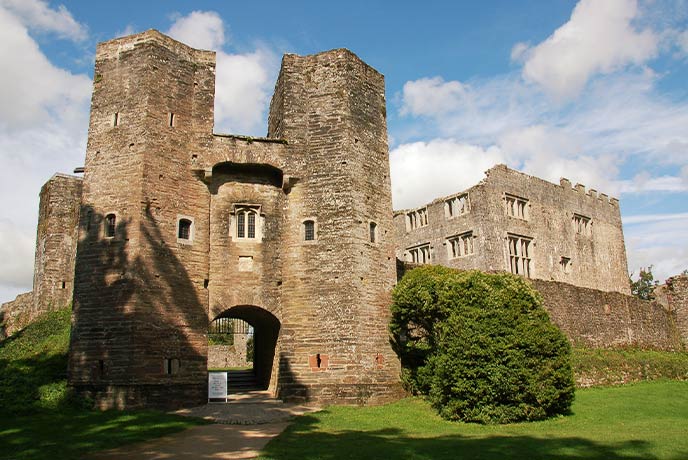
Berry Pomeroy, Totnes TQ9 6LJ
Nestled deep in a wooded valley near Totnes, the once-majestic Berry Pomeroy Castle lies in romantic ruins, swathed in tales of ghostly ladies and misfortune. Originally gifted by William the Conqueror to a Norman knight named Ralf de Pomaria, a manor house was built and remained in the family for 400 years before it was bought by Sir Edward Seymour (brother of Jane Seymour, third wife of Henry VIII) in the 1540s.
Abandoned by the Seymour family in 1688, the castle was left empty and it fell into ruin until it was rescued in 1977 by English Heritage. While much of the castle has disappeared over time, there’s still lots to see here. Take a look at the gatehouse with its narrow slots where objects and hot liquids were thrown down onto attackers, or the arched loggia that leads on to the Great Hall, once the biggest and grandest room in the castle.
Climb the steps to the first floor of the medieval gatehouse and you can peer at the stunning 16th-century wall painting depicting the adoration of the Magi, and gaze at the remains of the kitchen. Known as one of the most haunted spots in England, keep an eye out for the White Lady (said to have come to a grisly end) and the Blue Lady, said to have been the portent of death to the Seymour family. There’s a great audio tour that guides you through the castle, while the surrounding woodlands are just lovely for a wander down to the lake. There’s free parking, a café, and a shop, and dogs on leads are welcome throughout making this a lovely family-friendly day out.
Powderham Castle
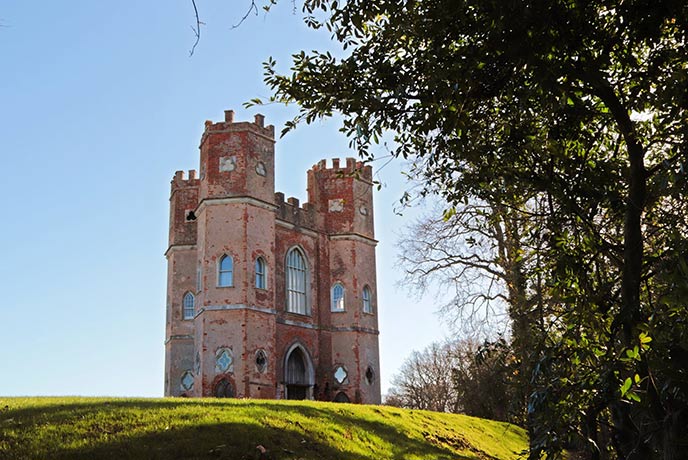
Kenton, Exeter EX6 8JQ
Set resplendently overlooking the estuary of the River Exe and built by Sir Philip Courtenay in the 14th century, Powderham Castle near Exeter has been a family home for over 600 years. With just a few minor alterations, little has changed over the centuries and a visit will find you exploring an ancient castle that’s still very much lived in today.
Home to some of the most elaborate Rococo interiors, including a swirling staircase hall that featured in the film The Remains of the Day. You can either explore the castle by yourself or tag on to one of their amazing castle tours: The State Room Tour, Living at Powderham, and Behind the Scenes. Each lasts around 45 minutes to an hour and offers a fascinating look into life here.
Outside, there’s over 150 acres of beautiful grounds to explore, such as the Rose Garden, Belvedere Tower, and Victorian Walled Garden. There’s lots for little ones to enjoy here too, from a petting zoo, playground, and community allotment to various fun trails and quests, bug hunting, crafts and animal encounters that includes trekking with an alpaca, grooming a pony or walking a goat. The castle also plays host to some of Devon’s top festivals for anyone looking to soak up the historic views while dancing along to some foot-stomping tunes.
Castle Drogo
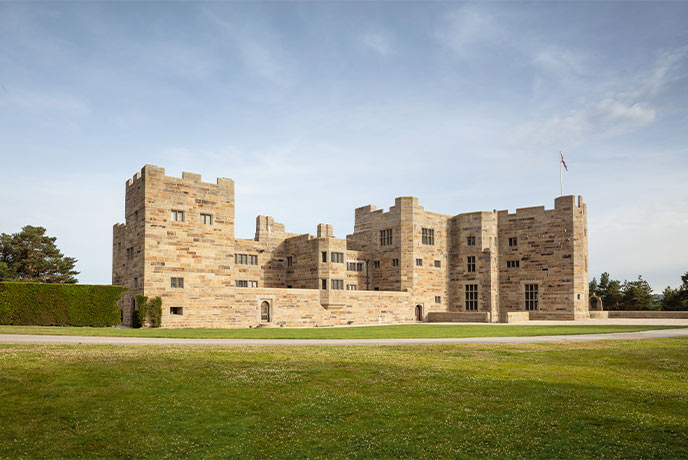
Drewsteignton, near Exeter EX6 6PB
This imposing edifice is the last castle to be built in England and was constructed between 1911 and 1930. Built for millionaire store owner Julius Drewe, Castle Drogo, located near Moretonhampstead, boasts stunning views over the Teign Valley and is a fantastic mix of ancient aesthetics and what was considered state-of-the-art living at the time.
Following a major renovation, the castle is once again open to the public and is well worth a visit to explore this beautiful home, from its Char de Triomphe tapestry, dating back to the court of King Louis XIV of France, to the innovative electric candlesticks that adorn the grand dining table and the use of hydroelectric power throughout the castle.
Outside, the beautiful gardens are the highest to be managed by the National Trust, with highlights including the sunken rose garden, the rhododendron garden, Mr Drewes path and the Bunty House – a charming playhouse modelled on a 1930s suburban home where little ones are invited to play. The castle also has its own chapel with a bell tower that can be visited for a quiet space for a moment of contemplation.
If you have time, take a walk around the wider estate around the Teign Gorge where you can follow the paths down to the river, or keep to the higher slopes for gorgeous views over Dartmoor - make sure to keep an eye out for buzzards and ravens! At the end of your visit, there’s a fantastic National Trust shop to potter around in and a café for refreshments.
Compton Castle

Marldon, Paignton TQ3 1TA
Set about 4 miles inland from Paignton, Compton Castle is a majestic fortified manor house dating back to medieval times, and has remained in the same family, the Gilberts, for over 600 years. With its curtain walls, towers, and portcullis, it looks every bit the proper English castle, with its incredible interiors boasting plenty of sights too.
Explore the Great Hall with its crackling open fire and intricate carved ceilings, the pretty Sun Solar (a private living room), the huge medieval kitchen where you can have a go at crushing herbs in a pestle and mortar, the Long Gallery with its beautiful stained glass windows, the gruesome dungeons and the impressive defences, which were believed to have been built to display social status as much as to protect the castle. You’ll also spot castle guides in Tudor outfits, who’ll point out interesting titbits (such as the hidden priest’s hole where Catholics hid during Elizabethan times), bringing the history of Compton to life.
Outside there’s a small but perfectly-formed garden for sunny strolls, with a pretty knot garden, rose garden with pergolas, kitchen herb garden and lawns with an orchard, Find the perfect place for a picnic under the apple blossom in spring, enjoy the dappled shade of the leaves in summer, and gaze hungrily at the plump apples in autumn. Please note that Compton Castle is only open between April and October.
Rougemont Castle
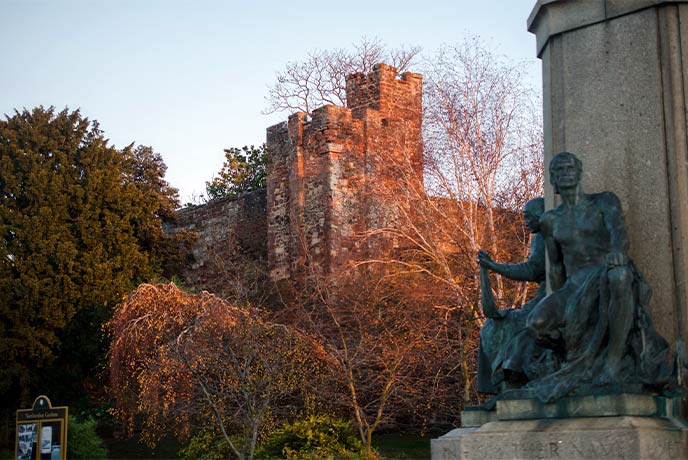
Castle Street, Exeter EX4 3PU
Once admired by kings, little remains today of the once-impressive Rougemont Castle (also known as Exeter Castle). Located in the heart of Exeter at its highest point, it is said to be the oldest standing castle building in the whole of England, built shortly after the Norman Conquest.
Mentioned in Shakespeare’s Richard III, who visited in 1483, the biggest section of the castle that still stands is the gatehouse, built with rust-coloured red stone (hence its name). There’s some interesting signage detailing the history of the castle, as well as a plaque commemorating three women, who in 1682 were the last in England to be tried and executed as witches. It’s well worth taking the time to find it when exploring Exeter for a glimpse into the city’s fascinating past.
Totnes Castle

Castle Street, Totnes TQ9 5NU
Standing proud in the heart of the town, Totnes Castle was originally a timber building with earthworks, before being rebuilt in the 13th century by a man called Juhel, a commander in William the Conqueror’s army. Commanding an excellent position over Totnes, which in Saxon times was an affluent centre for several industries, crafts, and a mint that issued coins, it was a bustling community to be sure.
While a ruin today and a shadow of its former self, you can still see the defensive arrow slits and the battlements if you have a keen eye, while a walk through the bailey will lead you to a large grassy space, which at one time would have housed the garrison as well as other timber buildings. In the bailey, you’ll find a Holm Oak that is said to be over 150 years old!
Once you’ve explored this area, climb the bank near the moat for a wider view of how life would have been centuries ago as you ascend to the top of the keep, where you’ll be met with spectacular views over the town and surrounding valley. Managed by English Heritage, do check out the website as the opening days and times are seasonal and can vary.
Okehampton Castle
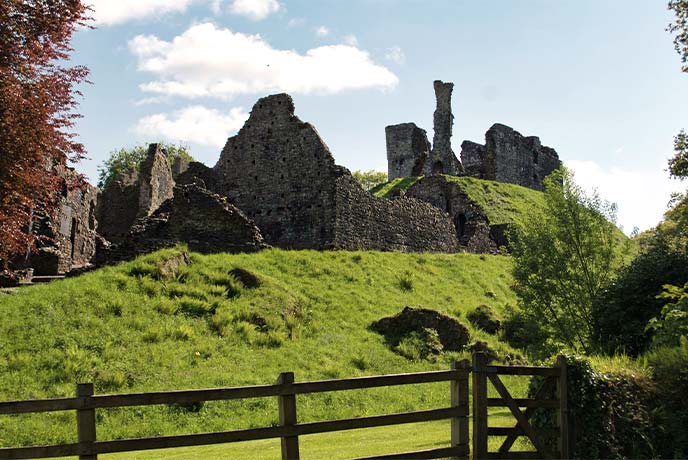
Castle Lodge, Okehampton EX20 1JA
Now a dramatic ruin, Okehampton Castle was once the largest castle in Devon. Starting life way back in 1068 just after the Norman Conquest, the site sits on a natural point overlooking the River Okement Valley - an excellent position for keeping watch over the area. Originally owned by Baldwin de Brionne, cousin to William the Conqueror by marriage, it was later renovated and extended by the Courtenay family into a sumptuous home. Unfortunately, the last Courtenay fell out of favour with Henry VIII in 1539, and the castle was left to fall into a ruin.
Today, you can walk around the site and original motte ditch and easily get a sense of how grand the castle would have been with its thick stone walls and huge gatehouse. English Heritage, who maintain and care for Okehampton Castle, has provided an excellent audio tour, which you can listen to as you wander around. There’s a picnic area near the castle to make the most of the idyllic wooded setting (pop into a nearby farm shop for some delicious local supplies), plus a shop by the entrance where you can pick up a souvenir or two of your visit. There’s also free parking close by in Okehampton and dogs on leads are welcome.
Dartmouth Castle
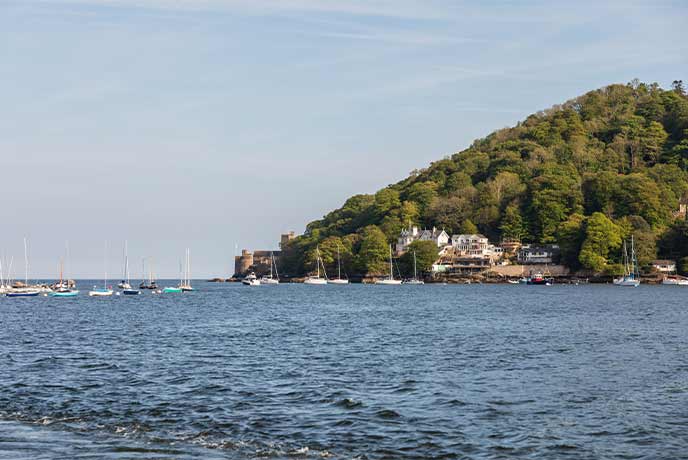
Castle Road, Dartmouth TQ6 0JN
Overlooking the sea and guarding the entrance to the Dart Estuary, Dartmouth Castle enjoys one of the most picturesque settings to be found in Devon. Over 600 years old, the fortress was built to protect the town and harbour during the Hundred Years War – and specifically to defend the River Dart, which was a hive of activity for trading wool, wheat, and other produce and importing wine from Bordeaux.
Over time, the fortress has been adapted and strengthened with gun towers to protect Dartmouth from French invasion and later the Spanish Armada in the 16th century. During the Civil War, the fortress changed from Parliamentarian control to Royalist and back again, and it was manned with guns in both World War I and World War II to defend against enemy ships and air attacks.
Pay a visit today and you can explore the fortress with its WWII gun house, Victorian gun battery, and the dark and foreboding passageways used by Victorian soldiers who ferried gunpowder from storage to the guns above. Head to the Gun Tower for the dramatic displays of weaponry and armour before ascending to the open roof for stunning views out to sea and over the town.
If all this exploring makes you hungry, there’s a tearoom next to the castle that’s the perfect spot for a cream tea, before taking a look at the English Heritage gift shop. There’s pay and display parking nearby and dogs on leads are welcome. You’ll also get a spectacular view of the castle from the sea if you arrive and depart by ferry. Please note that the castle is only open at the weekend.
Tiverton Castle
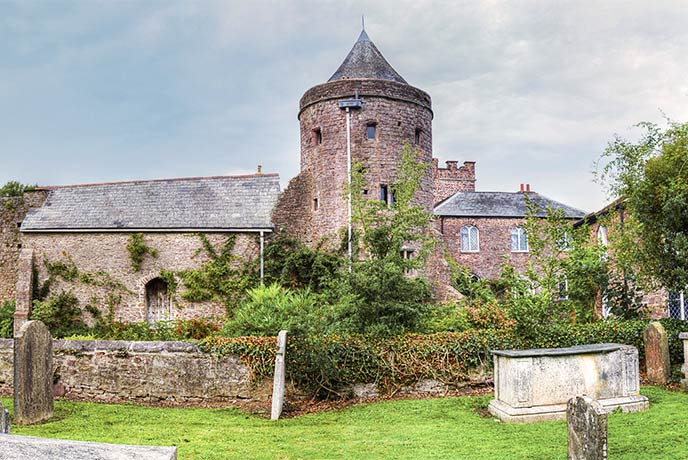
Park Hill, Tiverton EX16 6RP
Starting life as a motte and bailey castle, Tiverton Castle was built in 1106 on orders from Henry I and enlarged and improved during the 13th and 14th centuries. Later on, the castle was owned by the famous Courtenay family, one of whom married the daughter of Edward IV and became the Earl of Devon, before a series of family mishaps (such as falling out of favour with the crown) led them to lose it.
Apart from attack during the Civil War by General Sir Thomas Fairfax, the castle has remained a peaceful home that’s a lovely place to explore with a mixture of architecture from medieval times to the present, as well as beautiful walled gardens within the ruined parts of the castle. Open on Thursdays, Sundays and Bank Holidays, from Easter Sunday to the end of October, between 2.30pm - 5.30pm, this privately-owned castle is a short walk from the market town of Tiverton, where you’ll find lots of places for a drink or a bite to eat afterwards.
Feeling inspired? Take a look at our beautiful holiday homes in Devon and start planning your castle-filled, fairytale getaway today.



